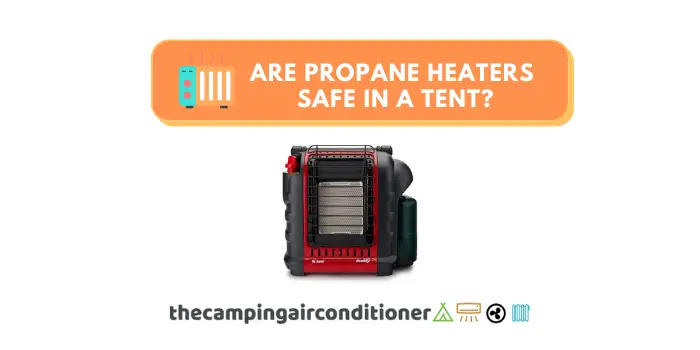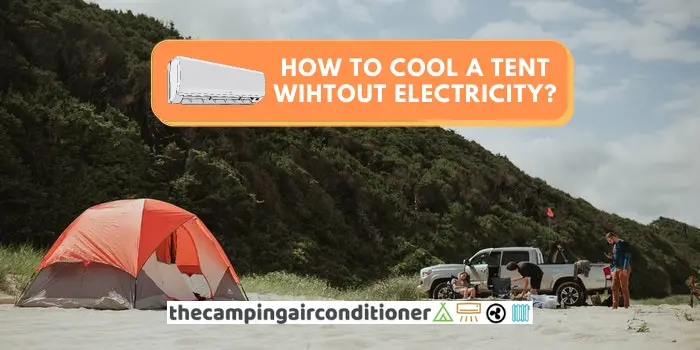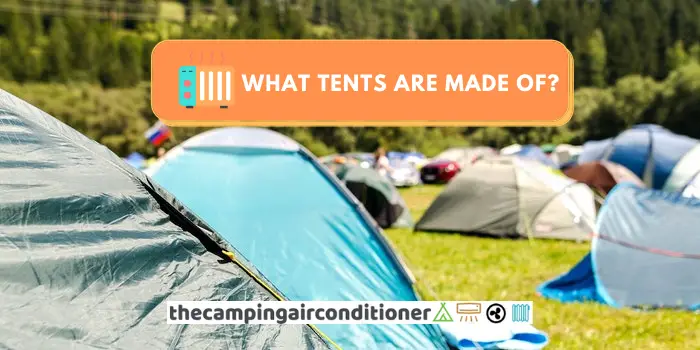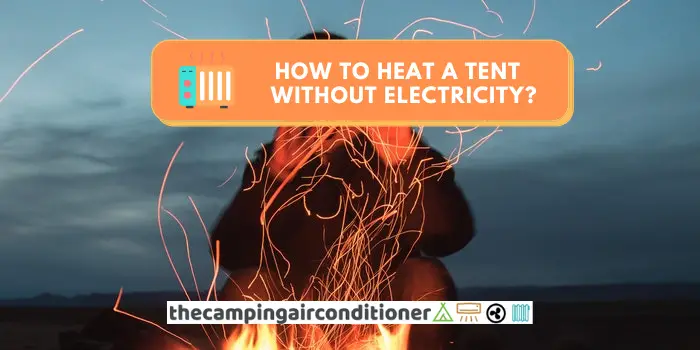Cold nights can be a hassle when camping. Luckily, with many tent heater options available in the market, you can easily pick a heating unit to tackle freezing weather. But, how to use a tent heater safely?
We’ve got everything you need to know to handle these devices safely and keep your tent warm for a cozy environment. Overall, you should ensure there is proper ventilation inside your tent and your heater has safety mechanisms to avoid potential accidents.
Keep reading this article, and we will explain all the details to you!
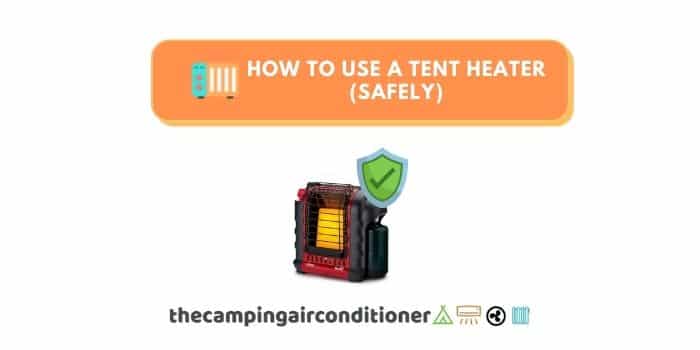
By the way, The Camping Air Conditioner is sponsored by readers. When you buy through one of our links, we may earn an affiliate commission at no extra cost to you.
What heaters can be used in a tent?
We divide tent heaters into two significant groups: electric devices and gas/liquid heaters.
Among many types of equipment, these are the alternatives that can be used to warm your tent and ensure a comfortable night:
- Propane Heaters (gas heater)
- Butane Heaters (gas heater)
- Kerosene Heaters (liquid heater)
- Electric Heaters
- DIY Tent Heater (Candle Heater)
You can also use a camping stove to snug your shelter on winter days. However, they require some safety measures, such as having a tent with a stove jack.
What are the risks of using a heater in a tent?
Whatever heating approach you decide to pick for your tent will come with risks. However, all of them are controllable and can be easily be mitigated.
Gas and Liquid heaters (Butane, Propane, and Kerosene) release carbon monoxide (CO) into the atmosphere when burning.
As a consequence, risks associated with CO poisoning increase. This is probably the most significant issue when using heaters inside your tent since it can lead to death.
CO is known as a silent killer, as it is odourless, colourless, which means you can get poisoned without feeling it. Further, the combustion process of gas and liquid heaters consumes oxygen from the environment and can significantly deplete its levels.
Electric heaters are a great alternative to these issues since they neither release CO nor use oxygen when operating. However, as with other heaters, they can overheat and ignite a fire inside your tent.
Unfortunately, candle Heaters (DIY option) also produce CO. However, the probability of CO poisoning is extremely low, given the levels of CO released in the atmosphere are extremely low. The most significant risk with this gadget is initiating fire, in the case of heater tip over.
How to safely use a heater in a tent?
Now that you know what type of heaters you can use in a tent and the risks associated with each alternative let’s discuss safety precaution measures to handle them.
- Whatever heater you use, make sure there is plenty of ventilation in your tent. Constant airflow will bring a fresh breeze inside your shelter and decrease CO levels. It might also help reduce and/or eliminate condensation inside your tent. A tent with a screen room area might be a helpful idea.
- Use a digital monitor to check CO levels. We suggest First Alert CO710, which comes with a 10-year built-in battery.
- Never leave a heater unattended – this includes turning off your heater when sleeping. There are several risks associated with overheating, which can start a fire inside your tent while you are sleeping.
- When using the heater in your shelter, remove all flammable stuff, such as plastic bags, paper, etc.
- Do NOT cover heaters
- Pick devices with auto-shutoff mechanisms for overheating and CO levels and ensure that your gas and liquid devices comply with the American National Standards Institute norms – ANSI Z21.103-2017
- Most Always follow manufacturer’s instructions when it comes to
Where to place a heater in a tent?
To improve the performance of your heater and ensure maximum safety, you should be correctly positioning your device in a tent.
First of all, we recommend using your heater above a fireproof mat (picture below). These mats will ensure proper thermal insulation and avoid heat being transferred through its base. They are cheap and foldable, being ideal for transport.
Secondly, place your heater in isolation and keep at least 20 cm from your tent walls. You don’t want your tent to melt or set fire by tent fabric ignition. Even though tents are produced considering flammability risks, the overheating risk is always there.
Thirdly, as discussed in the previous session, place your heater far away from any flammable gear. Isolate the equipment and ensure plenty of air circulation around it.
Avoid placing your heater close to any leaks since they can damage your equipment and put you in danger.
To finalise, ensure that you pick a tent heater with adequate size. Read this article if you want to know how many BTUs your device should have. But as a rule of thumb, consider the data in the table below.
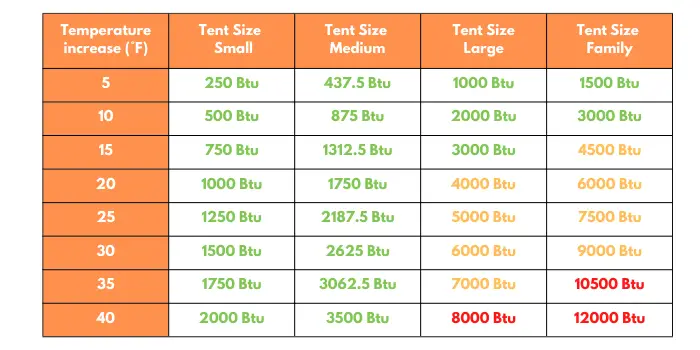
FAQ
How to heat my tent without electricity?
This article details some tips to help you heat your tent without electricity. The heating measures include:
- Choose the appropriate tent material
- Pitch your tent at the right spot
- Use warm blankets
- Bring the adequate sleeping bags
- Intake enough calories
- Use a hot water bottle.
- Try light exercise before going to bed
- Drink hot beverages
- Insulate your tent
- Use a portable heater
Do candle heaters produce carbon monoxide?
Yes, they do. However the amount of CO produced is minimal and risks of CO poisoning are mininal.
How cold is too cold for camping?
There are records of camping activities with temperatures as low as minus 70 Fahrenheit.
However, if you are not an experienced camper, we advise you not to risk yourself with temperatures below the 40 Fahrenheit threshold (around 0-celsius degrees).
What is the safest tent heater?
Electric heaters are the safest alternative, given they do not release CO into the atmosphere. However, if you don’t have electricity around your tent, propane heaters are a safe alternative, provided that you follow all the safety measures detailed above.
How to insulate my tent for winter?
Our tips are:
- Pick a suitable insulation material and properly place the insulator in your tent
- Insulate your tent floor
- Choose a tent with adequate size and a right tent fabric
- Avoid pitching your tent in open areas with excessive airflow
- Use the perfect sleeping bag
If you want to know more details about these tips, read this article.
Conclusion
Overall, heaters are very simple to use and handle. This article has shown many measures that will help you safely operate them and keep your tent warm and cozy!




